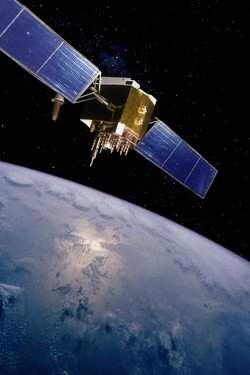Sun, Sep 16, 2007
 Boeing has successfully assembled
and integrated all flight hardware onto the first Global
Positioning System (GPS) IIF satellite. GPS llF will bring new
capabilities to the GPS constellation such as full onboard
encrypted military code, a new civil signal, crosslink
enhancements, signal power increases and longer design life.
Boeing has successfully assembled
and integrated all flight hardware onto the first Global
Positioning System (GPS) IIF satellite. GPS llF will bring new
capabilities to the GPS constellation such as full onboard
encrypted military code, a new civil signal, crosslink
enhancements, signal power increases and longer design life.
"GPS IIF is on track because of the team's stellar application
of back-to-basics program management," said Howard Chambers, vice
president and general manager of Boeing Space and Intelligence
Systems. "The performance of these subsystems is a testament to our
process-based management and to our lean manufacturing commitment,
and GPS IIF fully meets the specifications set forth by our U.S.
Air Force customer and places us firmly on track to deliver the
satellite for the first launch in 2008."
Boeing is building 12 GPS Block IIF satellites under contract
from the Navstar GPS Wing at the Space and Missile Systems Center
in Los Angeles.
The satellite's sophisticated L-band payload will include new
hardware that serves the civil user community. Designed to enhance
non-safety-critical applications, the signals will improve aviation
and other precision safety signals.
Technicians are preparing GPS IIF for key dynamic environmental
tests designed to confirm its structural design and mechanical
integrity. They also are attaching the solar panels and configuring
the satellite before it undergoes several physical tests. The tests
will help ensure robust mission assurance with an emphasis on
product integrity and mission success.
Each GPS IIF satellite will complete acoustic stress tests using
high-powered speakers to verify that the spacecraft can tolerate
the high sound pressure levels during launches; mechanical tests
similar to a separation test to make sure it disconnects cleanly
and correctly from the launch vehicle; tests of its deployable
mechanisms such as the solar wings and the antenna to ensure that
they release correctly on-orbit; and finally, GPS IIF will undergo
thermal vacuum testing to confirm its ability to operate in a
vacuum and under the extreme temperatures of space.
More News
Aero Linx: Model Aeronautical Association of Australia MAAA clubs are about fun flying, camaraderie and community. For over 75 years, the MAAA has been Australia’s largest fl>[...]
Touchdown Zone Lighting Two rows of transverse light bars located symmetrically about the runway centerline normally at 100 foot intervals. The basic system extends 3,000 feet alon>[...]
“Discovery and innovation are central to our mission at Virgin Galactic. We’re excited to build on our successful record of facilitating scientific experiments in subor>[...]
How To Get A Story On Aero-TV News/Feature Programming How do I submit a story idea or lead to Aero-TV? If you would like to submit a story idea or lead, please contact Jim Campbel>[...]
Student Pilot Reported That During Rotation, “All Of A Sudden The Back Of The Plane Kicked To The Right..." Analysis: The student pilot reported that during rotation, “>[...]
 ANN's Daily Aero-Linx (05.02.24)
ANN's Daily Aero-Linx (05.02.24) ANN's Daily Aero-Term (05.02.24): Touchdown Zone Lighting
ANN's Daily Aero-Term (05.02.24): Touchdown Zone Lighting Aero-News: Quote of the Day (05.02.24)
Aero-News: Quote of the Day (05.02.24) ANN FAQ: Contributing To Aero-TV
ANN FAQ: Contributing To Aero-TV NTSB Final Report: Cirrus Design Corp SR20
NTSB Final Report: Cirrus Design Corp SR20



